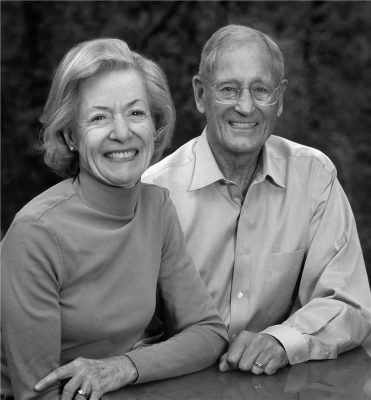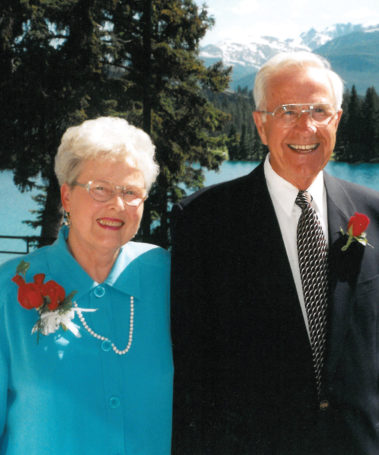History About
Our story begins in 1971, when the province of Alberta passed the Edmonton Community Foundation Act, laying the legal groundwork for the Edmonton Community Foundation (ECF).
The foundation came alive in 1989 when a group of generous philanthropists — John and Barbara Poole, George and Rae Poole, and Robert and Shirley Stollery — collectively donated $15 million. They invested in ECF because they saw it as a way to grow and support philanthropy and community development for generations.
ECF’s founding families made their game-changing contribution at the suggestion of Eric John Slatter, a respected solicitor, community advocate, and friend of ECF. If you visit our offices, you will drive down a laneway named in his honour — Slatter Way.
ECF’s assets grew to nearly $800 million at the end of 2023 and we have distributed more than $400 million to charities in Edmonton and across Canada (that’s about $35 million each year). We work our magic from downtown’s Hilltop House, a heritage building overlooking the river valley on the southern edge of Edmonton’s downtown. The three-storey mansion was built in 1912 by city businessman and former mayor John C McDougall, but the history of the land stretches back millennia.
Edmonton is situated in Treaty 6 territory and Region 4 of the Metis Nation of Alberta, a traditional meeting ground, gathering place, and traveling route for Indigenous peoples, including the Cree, Salteaux, Blackfoot, Metis, Dene and Nakota Sioux. We recognize that we are all treaty people — beneficiaries of the peace and prosperity the treaty created — and committed to working toward the equity and justice the Treaty promised.


1989-1995


1989: Edmonton Community Foundation opens thanks to a combined $15 million donation from John and Barbara Poole, George and Rae Poole, and Robert and Shirley Stollery.
1990-92: Lorne Leitch becomes ECF’s first executive director.
- In 1990, ECF completed the first full distribution cycle, allocating $1,088,012 to 60 different charities.
- The grant recipients included the Alberta Ballet, Ben Calf Robe Society, Edmonton John Howard Society, The Works Society, and Michener Park Education Society.
- In 1991, Jean Forest is President of ECF.
- Community Foundations of Canada (CFC) was formally constituted, and ECF becomes a member.
1992: The Winspear Foundation donates $4.5 million in assets to ECF.
- In its first three years, ECF distributed more than $3,790,000 in grants to more than 100 charities.
- Martin Garber-Conrad joins ECF’s board of directors.
1993: Alison B. Rice contributes $3 million to ECF.
1993: Bill Mathewson succeeds Lorne Leitch as ECF’s executive director.
1994-2005: Former Edmonton Police Chief Doug McNally becomes ECF’s executive director and significantly expands ECF’s presence and profile.
1995: ECF provides its first student award via a Winspear Bursary for classical music education. Since then, ECF’s Student Awards have expanded to include 18 programs granting close to $1 million annually.
1996-2001


1996: WillPower Wills Week is introduced.
1999: ECF removes the $30,000 cap limiting grant amounts payable and approves multi-year grant funding. This enables ECF to respond to pressing community needs.
1999: ECF actively builds Our Children’s Millennium Fund.
1999: ECF is a lead partner in establishing Leadership Edmonton.
2001: ECF commissions the sculpture “Return” by local artist Catherine Burgess, which is installed in TELUS Plaza south of Jasper Avenue. The three interdependent columns represent the three pillars of ECF: the donors, the Foundation, and the beneficiaries. All three combine to enhance the quality of life in our community.
2002-2008


2002: The Belcourt Brosseau Métis Awards (BBMA) Fund begins disbursing scholarship awards for the first time with a $12 million endowment. Since then, the BBMAs have grown to become the largest non-governmental support service for Metis education in Canada.
2005: Martin Garber-Conrad takes over as ECF’s CEO after earning community-wide respect for his work at E4C.
2005: Through negotiations with local developer Gene Dub, ECF was able to purchase and move into Hilltop House.
2007: ECF introduces Foundation Directed Initiatives (FDI). This allowed ECF to provide multi-year funding to organizations and projects deemed key by ECF’s Board and Committee members.
2007-2008: The Social Enterprise Fund (SEF) is established. SEF is a financing mechanism for charities and social enterprises. The late Bob Ward is hired as the first Executive Director.
2008: Edmonton & Area Land Trust is established.
2009-2016


2009: First issue of Legacy in Action magazine is distributed.
2011: The Young Edmonton Grants program is established. YEG offers youth in the greater Edmonton area up to $3,000 to turn their project ideas into reality.
2012: ECF has the laneway leading to its office named in memory of Eric John Slatter.
2012-2013: ECF initiates impact investing through the establishment of the Alberta Social Enterprise Venture Fund LP.
2013: ECF participates in Vital Signs for the first time.
2015: ECF completes construction of a new building, which provides additional office space while preserving the historic Hilltop House. The architecture firm Manasc Isaac designed the new building.
2016: ECF launches The Well Endowed Podcast.
2017-Present


2017: Cumulative donations to ECF from Eldon and Anne Foote reach $164 million, the largest charitable gift to a community foundation in Canadian history. Since its inception in 2000, the Eldon & Anne Foote Fund has granted a total of $43 million to hundreds of local charities.
2022: Tina Thomas joins ECF as CEO after an award-winning tenure at Edmonton Public Library.
We continue to enrich lives in almost every sector of society, both locally and beyond. Learn how by reading more about our initiatives.